Speak to an expert: 0333 0069769
How to clean your mattress, get rid of stains and keep your bed fresh and healthy.
If you have invested in a new mattress, you will want to protect your investment by looking after it. Well cared for, a clean mattress can give you at least eight years of use. When you consider that out of those eight years, you'll spend over 2.5 years laying on top of that mattress, it’s easy to see why it's so important.
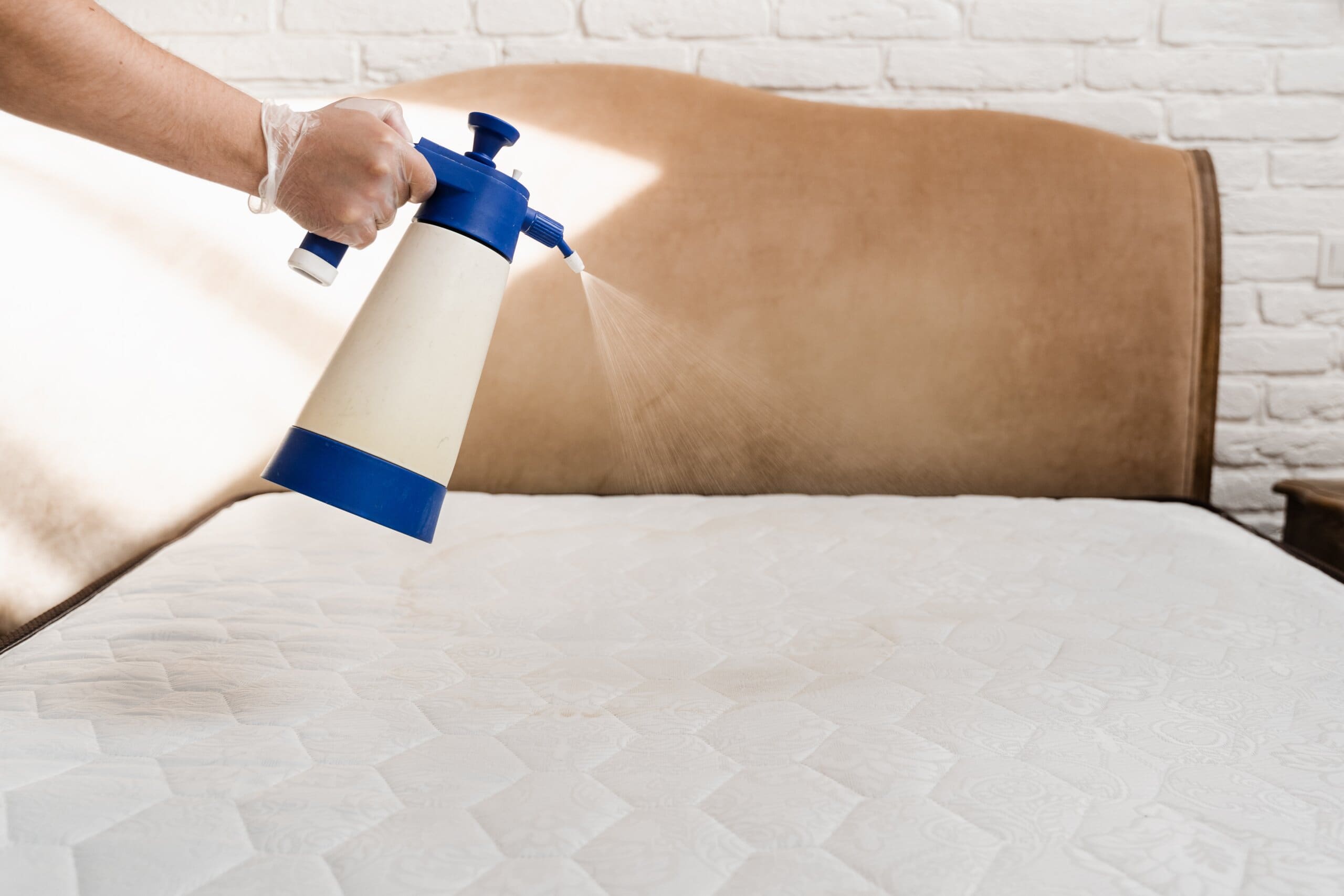
When you climb into bed at the end of a long day, you’re lying on more than you think. Left to its own devices, even the most comfortable mattress can become a home for dust mites and house allergens, and can trap dust as well as absorb sweat. Cleaning your mattress is the best way to keep your mattress fresh and ensure that it lasts as long as possible. In this guide, we let you in on all the secrets to keeping your mattress in tip-top condition.
Before we get started on how to clean a mattress, it’s worth knowing how often you should be doing it. Most manufacturers recommend that you should be giving yours a once-over twice a year. However, there’s no harm in doing it more frequently. Some users prefer to clean theirs seasonally, roughly once every three months, as this is when you'll want to flip or rotate your mattress too.
Cleaning your mattress has many benefits, including the elimination of dust mites and allergens, sweat, and other residues, helping to keep it stain-free, and the removal of pet hairs.
The care of your mattress starts the day it arrives. The mattress has been constructed to give you the right level of support and comfort but to get from the factory to you, it has had to be wrapped and moved, perhaps more than once.
When it gets to your house, you should take off all the wrapping and let the mattress breathe. Mattresses are usually wrapped in polythene, which may encourage the build-up of moisture, so it's wise to let the fresh air circulate your mattress for a while.
You should also give some time for your mattress filling to settle. You can sleep on it whilst this happens. But don't be alarmed if your mattress feels slightly different after a few nights of sleep. If you've gone for a memory foam mattress, you should leave it to fully expand before laying on it - our guide on how long a memory foam mattress takes to expand will help you.
Consider a mattress cover or protector. These additional layers protect your mattress from stains and reduce the likelihood of airborne allergens from dust mites.
Strip your mattress, wash your bedding once a week, and use a hot wash once a month. This helps to kill off any dust mites that may be in your bedding and prevents them from living in your mattress too.
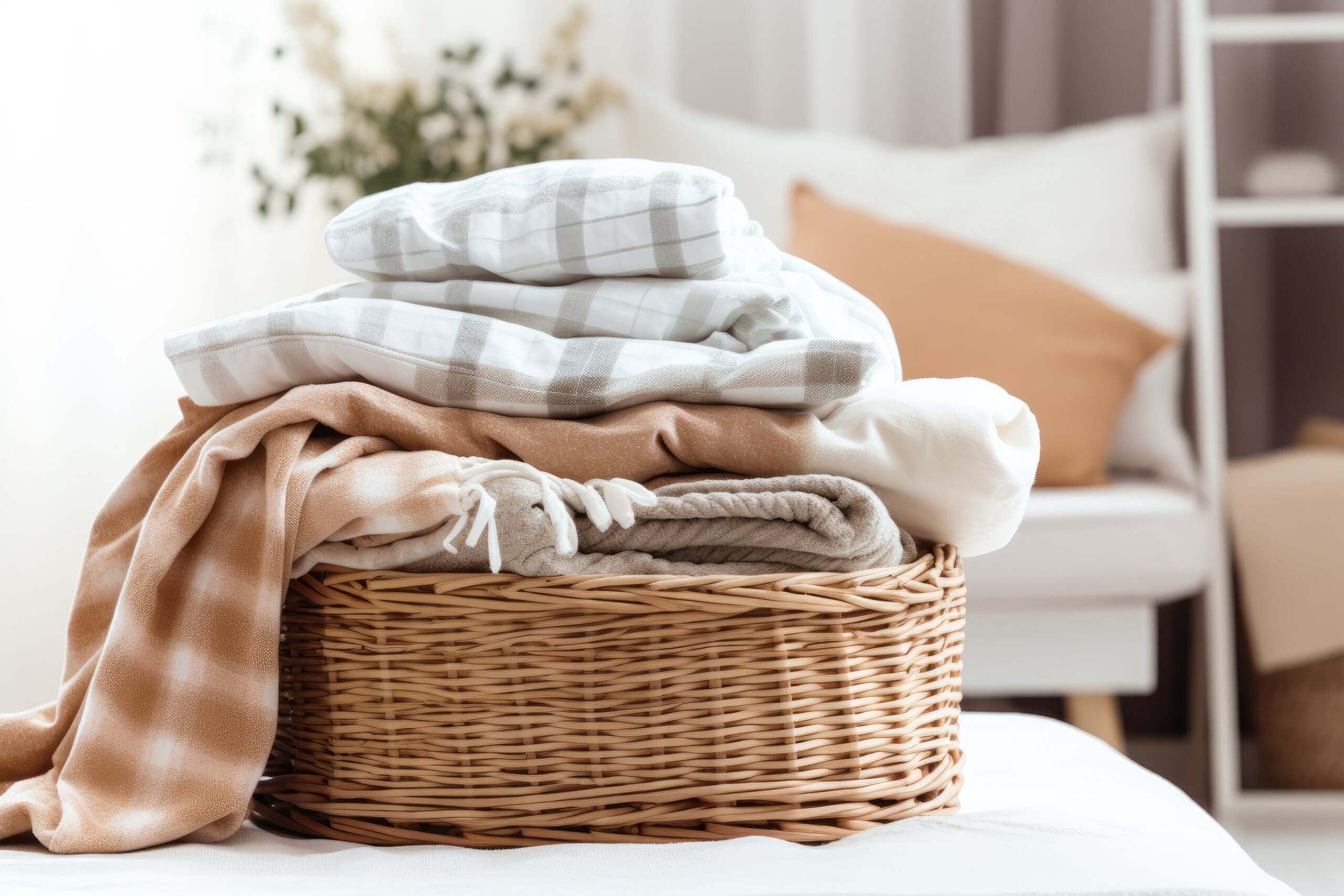
Airing is fantastic for your mattress. Dust mites think that your mattress is a perfect home, but cool air and light are exactly the opposite of their ideal conditions. Air your mattress as soon as it is delivered and continue to do so regularly throughout its life.
Every morning, turn back your covers, rather than making the bed. When you change the bed, leave the mattress to air for at least 30 minutes.
Carefully done, vacuuming can help to remove dust and debris from your mattress. You do need to be careful though, because heavy-handed vacuuming could damage the ticking or outer covering of your mattress. This not only compromises the support that the mattress can give you but may also invalidate your guarantee or warranty.
Vacuuming will not remove dust mites, but it will remove the dust and dead skin that they live on. Use a hand-held vacuum, or soft attachment to give your mattress a quick vacuum when you change your bedding. If you're particularly worried about dust mites and other allergens, consider a hypoallergenic mattress.
Getting stains out as quickly as possible can not only help keep your mattress looking its best but can also prevent the build-up of bacterial breeding grounds and unpleasant odours.
The National Bed Federation recommends that as soon as there’s been a spill, strip the bedding as quickly as possible. If it’s convenient, stand the mattress on its side to prevent any liquid from being absorbed.
For Number One and Number Two-style accidents, the recommended cleaning fluid is a simple mixture of water and a mild detergent. Wipe it away with a solution of cold water and antiseptic.
If your morning orange juice didn’t quite make it to your mouth, most manufacturers recommend using a mattress cleaner or mattress stain remover. These recommendations apply to milky stains, chocolate stains and even blood. For oily or greasy stains, the best advice is to use an aerosol grease solvent, rather than its liquid counterpart.
Check out our how to get stains out of a mattress guide, for more information about tackling stains. If you need to get specific, then we also have guides on how to get urine out of a mattress and how to clean a memory foam mattress.
If your staining issue is more severe than a simple spill, you might want to consider getting your mattress professionally cleaned. However, this can be an expensive and inconvenient process. So, it’s worth asking how much it’ll cost and exactly what’s involved. You may find that it will save both time and money to invest in a new mattress.
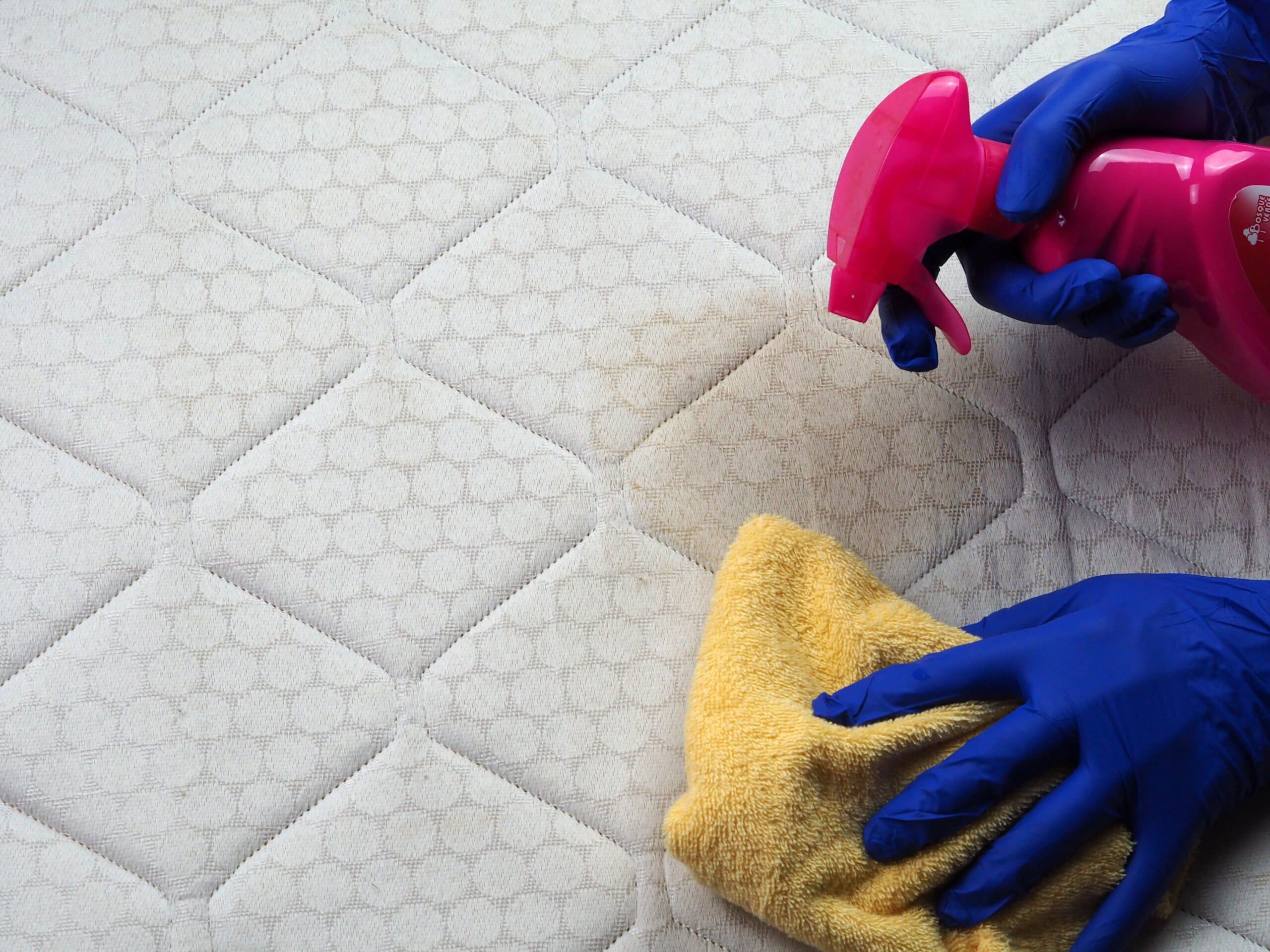
Whether your bed has been providing comfort to someone through an illness, or you want to give your mattress a complete refresh, sanitising your mattress can be a great way to give it a new lease of life.
The acidity in vinegar acts as a superb deterrent against dust mites. Mixing some with water and a few drops of an essential oil of your choice (we recommend lavender for a sleep-enhancing scent) will leave your bed smelling fresh. Plus, it will leave you secure in the knowledge that they’re not going to enjoy the experience.
While vinegar helps repel dust mites, it also breaks down the proteins in their droppings, which are responsible for the allergens that many sleepers react to. Distilled white vinegar is best and the solution should be sprayed, rather than poured, over the whole mattress.
Left unchecked, stains that hold a lot of moisture can lead to the growth of mildew. Some mildew produces mycotoxins which, if you suffer from asthma, can become a health hazard. A mattress stain remover should be enough to do the job.
However, you can also create your own deep-cleaning stain sanitiser, using 60ml hydrogen peroxide, one tablespoon of warm water, one tablespoon of salt, and one tablespoon of liquid soap. Apply this to the required area and leave it to dry. Once dried, the residue can be scraped off and then wiped down with a cloth dipped in hydrogen peroxide.
You may have seen online hacks on how to clean your mattress with bicarbonate of soda. Although it’s found its place on the Internet, this tip has been used for decades to freshen up mattresses that may smell a little past their sell-by.
The trick is to sprinkle yours with bicarbonate of soda and leave it for a few hours. Bicarbonate of soda is incredibly absorbent and will soak up sweat residue and associated odours. After a few hours, vacuum your mattress clean.
If you’re at a loss as to how to wash your mattress and things have got a bit out of hand, there’s always the professional route. Using a professional mattress cleaner can be a good idea for mattresses in serious need of rescuing. Typically, they’ll involve the use of steam cleaners and UV lights, to kill dust mites and break down allergens. However, as before, this can be an expensive undertaking and you might find it less costly to buy a new replacement.
How do you clean and sanitise a mattress? Head for the drinks cupboard! Vodka has long been used as an antiseptic around the house and the good news is that it can be equally effective on your mattress. There’s no need to use top-of-the-range stuff; anything cheap and cheerful will do.
Pour some into a spray bottle and spray your mattress, before leaving it to dry. Alcohol evaporates quicker than water, so it will dry completely in a fairly short time. If you’re worried about the odour of alcohol, which should be minimal, you can add a few drops of your favourite essential oil to the spray bottle.
Whilst all mattresses should have been tested to British Standard 7177, which covers the flammability of mattresses and other furniture, it's still inadvisable to smoke in bed.
The risks of falling asleep with a lit cigarette are well documented by the Fire Service. As you're already sleeping, you could be very susceptible to the toxic smoke that could be released by your bedding or your mattress. It's far safer to restrict your smoking to other parts of your house or, even better, outside.
If your mattress is coming to the end of its natural life, you may find that the ticking is threadbare, or that you can feel the springs through the mattress cover. Don't ignore this - start looking for a new mattress. Exposed springs and leaking filling can be dangerous both to adults and children. It's best if your mattress doesn't get into this state at all, but if it has, it's time for a new one.
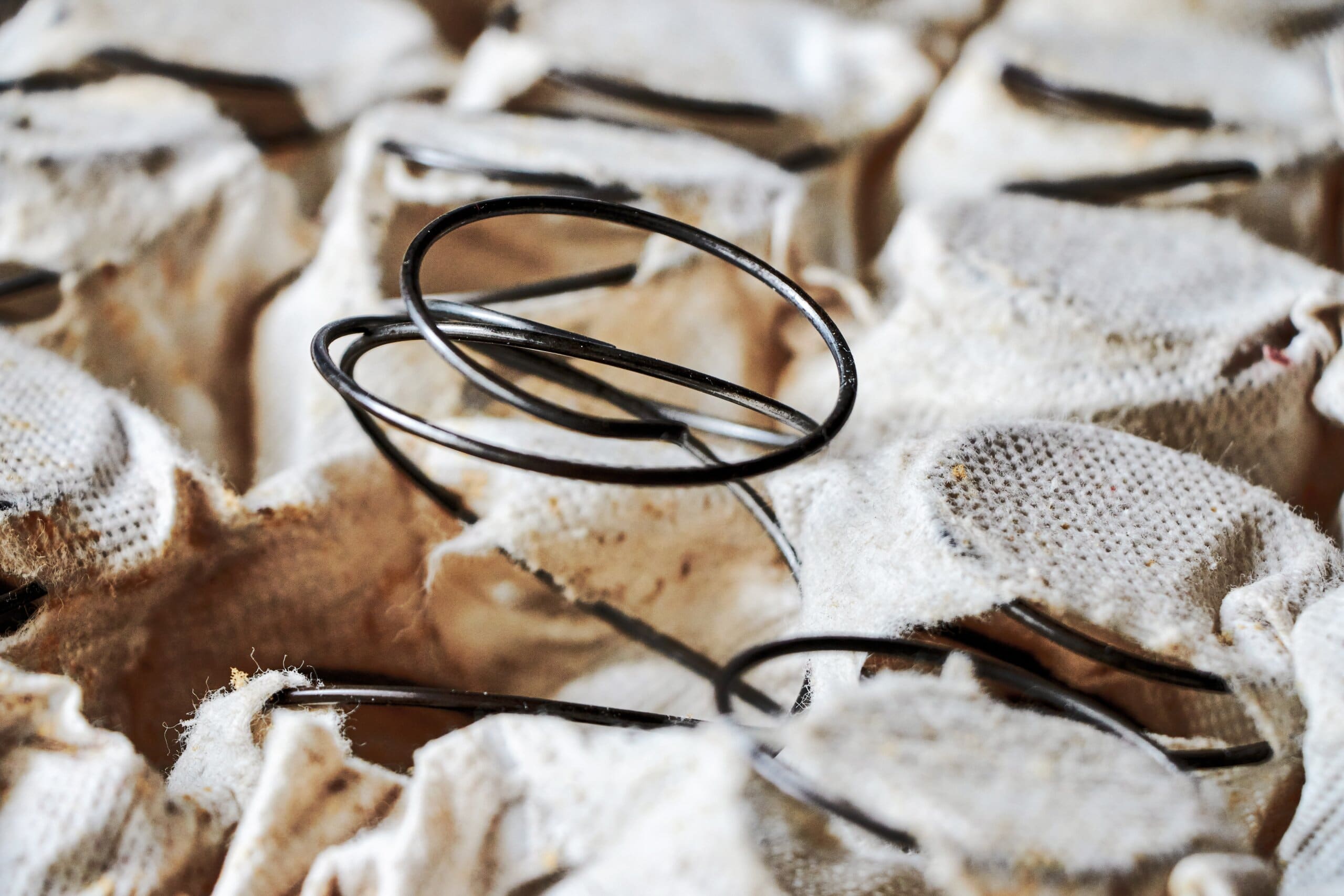
Many mattresses still require flipping over regularly to keep the filling evenly distributed and to vary the load on the springs. Most mattresses are very heavy - particularly when you get to a king or super-king bed - and you shouldn't attempt to turn one by yourself.
The size and weight of the mattress mean that you could damage your back, shoulders or neck. If your mattress needs to be turned, always ask for help. If you think you could have a problem finding someone to help, think about buying a non-turn mattress, which only needs to be rotated from head to foot.
For help and advice on turning or rotating your mattress safely, read our helpful guide on flipping your mattress.
It's almost impossible to control the dust in your home. Traditional cleaning may just move the dust from one place to another. But as 80% of household dust is made up of our dead skin, we're always producing more.
It's in this environment that the dust mite thrives. Practically invisible to the naked eye, dust mites thrive on the dead skin we shed and in warm, moist conditions. It may sound unsavoury, but we're all living in close contact with dust mites all the time.
Your mattress is one of the key places that dust mites like to live. It's warm, cosy and constantly fed with the fluid and dead skin that we lose at night. In many cases, it's the enzymes released in dust mite droppings that cause or inflame allergic reactions - particularly asthma or other breathing problems.
There are things that you can do to help reduce the number of dust mites in your home - although eradicating them is a huge, expensive task, and a full-time job. Even if no one in your family suffers from allergies, it's beneficial to your health to clamp down on dust mites. Following our tips for cleaning your mattress in this guide will help to keep dust mites to a minimum, but if you're really concerned, then consider an anti-allergy mattress.
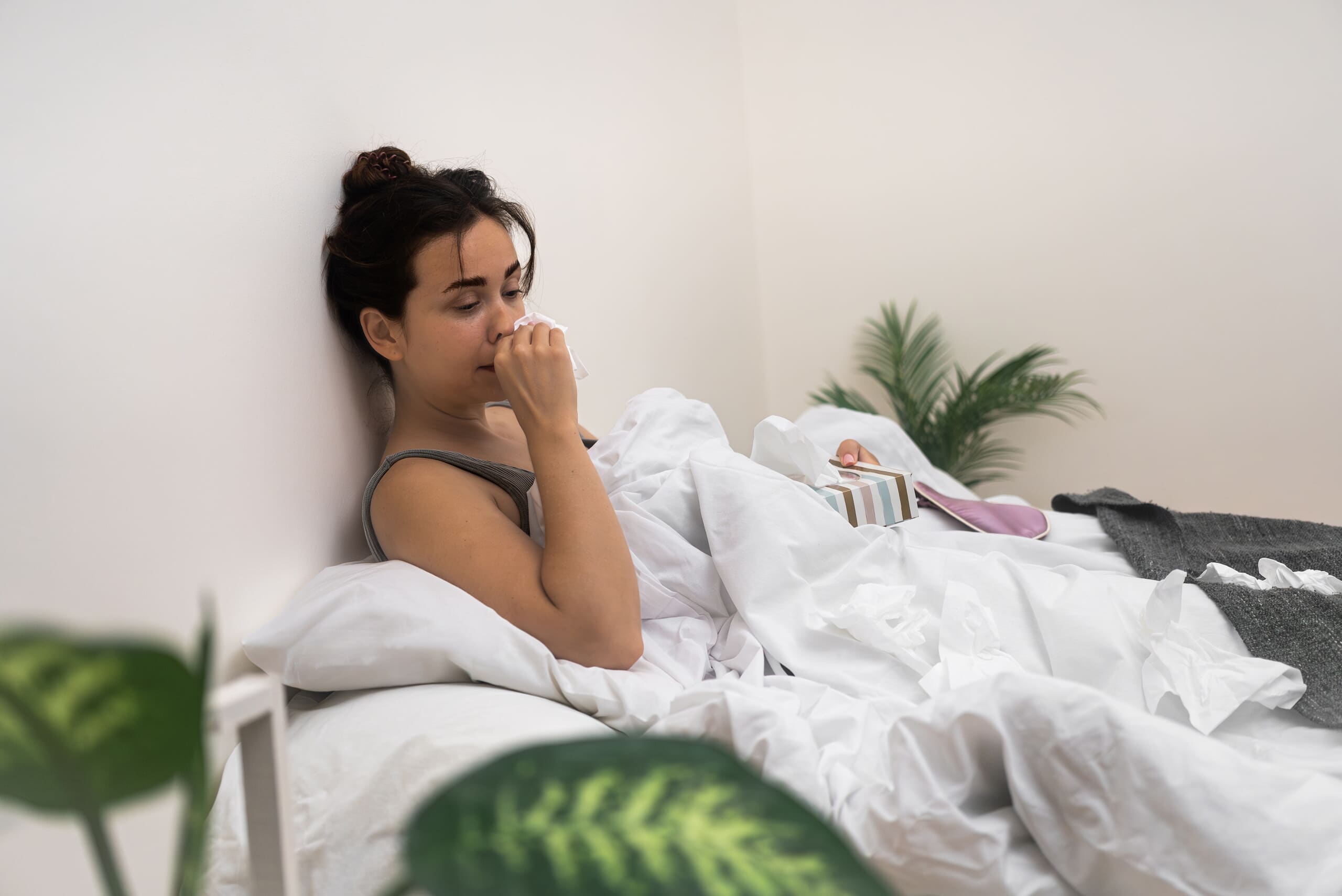
It's generally accepted by mattress experts that protecting your mattress is one of the ways you can make sure that it lasts as long as possible. Whether you're protecting a child's mattress during toilet training or protecting your own mattress against wear and tear, it's worth investing in a little extra protection.
There are many mattress and pillow protection products on the market. Some of these are for protecting the mattress and some are for protecting you:
If you want to protect your mattress from stains and other external damage, invest in a mattress topper. They are often padded for extra comfort, and easy to wash. They slip over the top of your mattress, giving you an extra layer of protection and comfort, helping to prolong the life of your mattress.
Offering greater protection than toppers, mattress protectors are designed to lengthen the life of your mattress. From waterproof protectors to those that prevent dust and mites, a protector is highly recommended.
Waterproof covers are essential for children who are toilet training or are having bed-wetting problems. A good child's waterproof cover protects the mattress against wetness and odour and can be easily cleaned, making the process as hassle-free as possible.
A wide range of waterproof covers is also available for adults who need to protect their mattresses because of light or heavy incontinence.
Failing to protect your mattress in this way could lead to problems with the mattress ticking and filling and shorten the life of your mattress.
Dust mites live in mattresses and pillows, feeding on the moisture and dead skin we leave behind when we sleep. It's the enzymes released by dust mite droppings that can increase the likelihood of an allergic reaction.
Whilst a specially treated allergy cover cannot combat the dust mite problem by itself, it can help to reduce the number of allergens that are released into the air we breathe every time we turn over in bed or move around our room.
Available for all sizes of beds, including cots, and also available for pillows, an anti-allergen cover may be the first step to improving your health.
It can sometimes be hard to determine exactly when is the best time to replace that old mattress with a new one. To find out more about when you should update your mattress, check out our guide on how long a mattress lasts, with tips on how to know you need a new one. Our MattressFinder™ quiz will help you find a new mattress that's perfectly suited to you in just a few simple clicks, and with our award-winning free next day delivery service, you can enjoy a fresh, brand-new sleep set-up as soon as tomorrow.